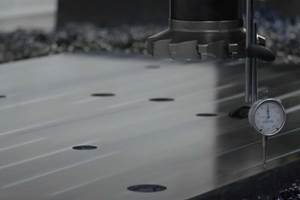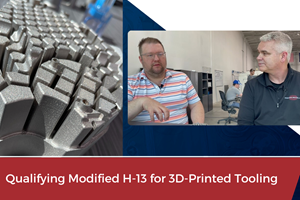Material Matters
Hardness, machinability and strength are the bottom line as materials manufacturers and suppliers continue to reduce moldmakers’ leadtimes without sacrificing quality or cost.
Like other segments of the industry, materials suppliers have spent the last decade continuing to supply the better steel and alloys that will help mold manufacturers reduce both machining and leadtimes while keeping costs down and increasing profits—and they see this trend continuing in the future.
According to Paul Britton, National Sales Manager for the Mold Products Division of International Mold Steel (IMS) Inc. (Florence, KY), the past 10 years have seen an “explosion in offshore tooling being used in the USA. This has made it more difficult for mold shops in the USA to compete using technologies that have existed for the past 10 or 20 years. Also, in the last few years mold shops have had to deal with ever rising steel prices. These two issues have had a large impact on domestic tooling. Tool shops have been asked to do more for less. What mold shops have to realize is that there are products out there that will save time and money and in the long run make them more competitive. Mold shops can use better steels. By better steels I mean steels that remove the problems of the past (hard spots, stress reliving, weld cracking, movement of the steel, cutter life, etc.). These issues are gone with the ‘better steels.’”
Tom Hazen, Sales/Marketing Manager for North American Tooling, Brush Wellman (Cleveland, OH), weighs in on Britton’s “better steels” notions. “Materials suppliers have spent the last decade continuing to supply the better steel and alloys,” he emphasizes. “Moldmakers are looking at copper-based alloys because they offer high conductivity, which promotes uniform cooling. They also offer high hardness and better wear resistance. Materials possessing these properties are proving faster cycles, helping mold manufacturers reduce both machining times and leadtimes while keeping costs down and increasing profits—and this trend should continuing in the future. These copper-based alloys benefit the mold build process in that they are used as inserts used to replace intricate areas of a mold where uniform cooling is necessary, but just not happening with the original mold material. Copper-based alloys work well as inserts in P-20 and 420 stainless molds. End products that have more uniform cooling see less warpage, reducing the amount of flawed pieces thus reducing scrap.
Material Challenges and Solutions
On the manufacturing level in general, streamlining the supply chain has moved front and center over the past 10 years, Hazen maintains. “Customers started to move away from buying a product based on piece price/pound price alone and more toward the total cost of acquisition,” he explains. “Speeding up the cycle time to create more in less time, reducing scrap, managing inventory—philosophies that are commonplace today really started emerging. One of the challenges we faced as a material supplier was to create a material to address these newer ideas in manufacturing. If we could prove our material could increase speed to reduce cycle time and also reduce scrap, then our customers could simply make a material change in their molds rather than go through the capital expense of all new equipment.
“Being an engineered materials manufacturer (a manufacturer that engineers materials based on the needs and desires voiced by our customers), another challenge we face is to find ways to create alloys our customers need,” Hazen continues. “We listen to the market and work with our customers to create alloys they can use. While challenging at times, it also has positioned us to now be able to offer both beryllium and non-beryllium containing alloys.”
According to Britton of IMS, new materials seem to arrive every year; however, the market does not take advantage of these offerings. “There are quite a few new P-20s on the marketplace,” he comments. “These materials offer unique differences to the P-20s from years gone by. Case in point, PX5 is a material that has been around for quite some time. It offers huge savings to the OEMs and molders—a 50 percent reduction in machine time, 300 percent increase in gun drilling speed without any hard spots that could cause the drill to wander, the ability to weld the material cold without the fear of cracking, not having to stress relieve even after heavy machining, consistent hardness from surface to core of the material, and extended cutter life of their tools. All these benefits have a direct impact on the cost of the tool. Some other new tool steels just arriving on the market will eliminate the need for heat treating. Customers could go right to finish machining—saving a large amount of time that the material is out of their shop being heat treated.”
Product Line Changes
According to Hazen of Brush Wellman, one of the biggest changes in the last 10 years is how high-speed machining has become imperative to building molds faster. “Providing an alloy that has great machinability has complemented this evolution within the industry,” he says. “We now manufacture an alloy that can be machined nearly as fast as aluminum tooling plate. “This allows the moldmaker to produce a mold with a 30 Rc thermal conductive alloy. One of our alloys has great machinability and a consistent grain structure. With 30 Rc, it exhibits good wear resistance. It is similar to P20, but with better thermal conductivity.”
International Mold Steel has been expanding its service capabilities to add value to their products—at the request of their customers. “We can machine a block (6" x 14" x 16") six sides square to within .0008" TIR in around 50 minutes,” Britton states. “With a normal vertical CNC piece of equipment or grinder it would normally take around three to four hours. Our customers love this service that we have provided. We also are adding a gun drill. By having these processes in-house we reduce our customers’ costs and leadtimes—and make them more competitive. We achieve this by doing more for them. In today’s market it is difficult to find people who can do basic machining (squaring drilling, etc.). Moldmakers want their key people to concentrate on the tough parts of making their molds. Therefore, they turn to us to do the squaring, drilling, basic machining needs.”
Future Forecast
Material suppliers will continue to strive to improve their offerings. “We see that leadtimes for molds will continue to decrease,” notes Brush Wellman’s Hazen. “More complex part designs will be required. Material inventories will be critical to help moldmakers achieve these deliveries. We will continue to work with our customers to develop materials they need in the future, but in this mature industry, we find our customers to be satisfied with what we are offering them today. Thermal conductive alloys will continue to be in the mainstream of moldmaking/plastic injection molding.”
Britton of International Mold Steel concludes, “Over the next 10 years we believe that we will continue to add better products that will reduce customers cost and leadtimes; and we also will add more equipment to help make our customers more competitive.”
Related Content
Qualified Tool Steel Enhances Thermal Transfer, Long Tool Life
Next Chapter Manufacturing has successfully qualified HTC-45 tool steel, an optimized version of H13, to support better thermal transfer and faster cycle times for molders and die-casters.
Read MoreHow to Produce More Accurate Molds and Reduce Rework
Patented micro-milling process for manufacturing steel plate flat and parallel helps mold builders shorten mold build times and increase accuracy.
Read MoreAdvancing Moldmaking and Plastics: Trends in 3D Printing, Automation and Sustainability
NPE 2024 showcased the latest trends and technologies in innovation, efficiency and sustainability for moldmakers and molders, featuring advancements in 3D printing, automation, design and virtual reality/augmented reality/artificial intelligence.
Read MoreVIDEO: Qualifying Modified H-13 for 3D-Printed Tooling
Next Chapter Manufacturing and International Mold Steel discuss their partnership to qualify a modified H-13 for tooling applications.
Read MoreRead Next
Gas Permeable Mold Steel
The use of venting material in appropriate areas can eliminate gas buildup, reduce injection pressure, lower cycle times, gloss levels and substantially reduce scrap and reject rates.
Read MoreAre You a Moldmaker Considering 3D Printing? Consider the 3D Printing Workshop at NPE2024
Presentations will cover 3D printing for mold tooling, material innovation, product development, bridge production and full-scale, high-volume additive manufacturing.
Read MoreHow to Use Continuing Education to Remain Competitive in Moldmaking
Continued training helps moldmakers make tooling decisions and properly use the latest cutting tool to efficiently machine high-quality molds.
Read More




















